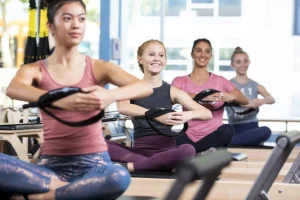Fitness trainers typically work in gyms or fitness centers, leading group fitness classes and offering individual coaching. In some instances, however, more specialized facilities such as yoga studios or CrossFit boxes might employ them instead.
Typical tasks involve conducting fitness assessments with new clients, including body measurements and discussing exercise goals and health history as well as designing workout programs. Furthermore, they may introduce new equipment, techniques or exercises.
Motivation
Trainers can assist in setting weekly goals and monitoring progress; this makes it harder to skip workouts. Furthermore, trainers can help uncover what motivates you so you stay on the path towards fitness outside the gym environment.
An effective trainer can teach you how to exercise safely and correctly, ensuring you don’t injure yourself while reaping maximum benefit from each session. They’ll also show you how to use various fitness equipment properly as well as suggest exercises that target specific muscle groups.
Trainers can also help keep you focused on the broader picture of overall health and wellness, including diet and stress management. They can point out any changes that might impact your fitness goals and suggest ways to manage them, while helping prevent overtraining by including rest and recovery into your workout regimen.
Insight
Fitness trainers should offer more than just workout regimens; they should help their clients understand why they’re engaging in certain practices, how it will impact them, and their long-term goals.
For example, this requires having an in-depth knowledge of anatomy, kinesiology, biomechanics and exercise physiology as well as psychology, nutrition and the ability to communicate and inspire change within people.
Insight is the ability to recognize an important connection among different elements of a problem and reach a solution through four stages of behavioral processes: impasse, fixation, incubation and eureka moment.
Personal fitness trainer demand in Europe is projected to increase during the forecast period due to increasing awareness about health and fitness as well as an increasing number of dual-income households, leading to greater gym memberships, which in turn are fuelling an expansion in personal fitness trainer markets.
Support
Trainers do more than instruct their clients what to do in the gym; they act as support systems throughout their fitness journey, which often has its ups and downs. Trainers celebrate milestones achieved, encourage when things become challenging, and assist clients in discovering ways to push themselves harder in their workouts.
They offer advice and guidance on a range of other issues, such as diet and lifestyle changes. In addition, they have an array of exercise equipment and techniques available.
Depending on the organization, some trainers may also be responsible for marketing and sales activities as well as administrative duties like client paperwork and record-keeping. Some may need to perform hands-on instruction with clients which may involve touching inappropriately; in addition, their style must adapt to meet different client needs including those with physical limitations.
Experience
Fitness trainers begin their services with an initial fitness assessment to evaluate a client’s current strength, flexibility and endurance levels. From there, a personalized exercise program can be developed that takes both their goals and fitness level into consideration.
Fitness trainers use training sessions to guide clients through workout routines that are customized to help them meet their fitness goals, such as cardio, weight lifting or yoga. Furthermore, fitness trainers educate clients on proper technique in order to reduce injuries and maximize workout effectiveness.
Fitness trainers typically share their success in meeting health and wellness goals with others by sharing what worked for them with clients. Their personal journey often motivates them to seek certification and a career in this area; some colleges even offer bachelor’s degree programs with an internship/practicum course option, which places students into real gyms so that they gain experience before graduating – such as courses such as kinesiology, anatomy, exercise psychology and many other core subjects.





